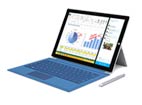The bloom is off the rose for the tablet. The frenzied rise of the form factor during the past half-decade is nothing short of amazing. Driven by Apple’s iPad, the tablet moved from being a niche product to a central focus of the mobile computing world seemingly overnight.
But it looks as if the wild ride may be ending, or at least moderating. Last week, IDC almost halved its original estimate for worldwide sale of tablets for 2014. Tablet shipments still are growing, but at a rate of 6.5 percent year-over-year, not the originally projected 12.1 percent.
The recalibration clearly isn’t a surprise. A story in eWeek noted that the move followed consecutive quarters of disappointing shipment numbers. The IDC report also suggests that North American and western European markets feature medium-size and larger devices, while smaller devices dominate in the rest of the world. That will have an impact on margins.
The IDC report was far from the first sign that after the initial splash, the level of tablet demand was reaching more reasonable and sustainable levels. In late July, Walt Mossberg at Re/code posted a Q&A with Best Buy CEO Hubert Joly in which he commented on the tablet trend and what may be taking its place:
The tablets boomed and now are crashing. The volume has really gone down in the last several months. But I think the laptop has something of a revival because it’s becoming more versatile. So, with the two-in-ones, you have the opportunity to have both a tablet and laptop, and that’s appealing to students in particular. So you have an evolution. The boundaries are not as well defined as they used to be.
A third harbinger of bad news for tablets came from TrendForce, an analysis firm in China. The press release notes the same general decrease in tablet sales as IDC and Mossberg. It is unclear precisely what area the study refers to (worldwide, Asia-Pac or Taiwan), but the overall trend is the same.
Yet in 2014, their novelty seems to have worn off. Prices have bottomed out. Low-price notebooks are stealing away tablet market share. As a result, branded tablets will experience negative growth for the first time this year, said Caroline Chen, a notebook PC analyst with TrendForce, a Taiwan-based market intelligence firm. Chen expects 153 million brand-name tablets will be shipped in 2014, a year-on-year decrease of 1.8%. Notebook shipments, on the other hand, will increase 1% on year to 171 million, she added.
Comparison with the IDC report suggests that the TrendForce numbers are worldwide. But the bottom line is that the explosive growth of tablets was not sustainable. The fact that they have come down to earth but still are in positive territory actually is good news for the form factor. No sector is immune to the laws of business gravity: Nothing stays up forever. It will be interesting, and of course important to the tablet sector, to see if the next quarterly reports show tablets continuing to drop or if they will find long-term equilibrium.
Carl Weinschenk covers telecom for IT Business Edge. He writes about wireless technology, disaster recovery/business continuity, cellular services, the Internet of Things, machine-to-machine communications and other emerging technologies and platforms. He also covers net neutrality and related regulatory issues. Weinschenk has written about the phone companies, cable operators and related companies for decades and is senior editor of Broadband Technology Report. He can be reached at cweinsch@optonline.net and via twitter at @DailyMusicBrk.



